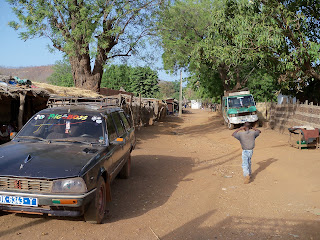Transport is usually the worst and most unpleasant part of living in Senegal. Unless you're well-to-do and have your own car and driver the "public" transportation system is made up of a chaotic, ramshackle network of privately owned beat-up buses, rusty jumbo-vans, smaller-but-equally-rusty vans and mini-vans, pick-up trucks, horse/donkey-drawn
charette carts, and safari cars. It's expensive and unpredictable (cars leave the garage as they fill up, so you wait three minutes or nine hours), the guys in charge of cutting tickets are usually loud, aggressive, and will often stretch the truth to pressure foreigners into buying tickets, and the baggage guys frequently try to extravagantly overcharge people (last time I went from Tamba the guy tried to charge 2 000 FCFA for a bag that should cost 500 FCFA) but they also tend to relent pretty quickly when you tell that that you've been here before and you know the price.
 |
| A typical transport receipt |
Each city has a "garage," which is just a big parking lot where cars and buses park and wait for passengers. The garages in Dakar and the other big cities are sprawling and hectic, filled with vendors and ladies selling
ceeb u jen, but the mayhem is somewhat organized. There are garage managers, and the guys in charge of selling tickets who make sure that cars get passengers and leave in the proper order. In the smaller cities, like Kédougou the garages are smaller, slower-paced, and more manageable. In a mid-sized village like Salémata the "garage" is just a bench in front of a sandwich shack, with a guy who sits around, making tea and writing out little ticket stubs. (I happen to glue all my travel tickets, baggage stubs and other paper miscellany into my journal, so at this point I have a comprehensive catalog of the kinds of hand-written receipts that there are in Senegal.
We don't get many nice transport cars out in Salémata on account of our road being rough, dusty, unpaved, somewhat washed out in a few places, and 80 kilometers (about 50 miles) long. It gets worse once the rainy season starts; the road gets muddy, occasionally floods completely by the bigger bridges, and we don't get very many cars at all.
 |
| A sept-place and a green van in the Salémata Garage |
 |
| The nicest vehicle in the Salemata Garage that morning |
I got lucky with this car because it had decent-looking tires, the engine sounded ok, the uplostery was still pretty much intact, and it had been painted pretty recently. The interior (below on the left) looked pretty nice. The photo below in the right is of the Salémata garage and main street, where the weekly lumo market happens on Tuesdays. There weren't many people around this morning (which is partly why I felt comfortable taking photos), just people stopping on to buy bread and boutique owners sweeping garbage into little piles and lighting little trash fires.
I only had to wait for about an hour and a half, which really isn't too bad. The car also didn't stop that many times to pick people up along the way, so it never filled up to the point of being ridiculously over-capacity. They also let me hop out right in front of the Peace Corps house (conveniently right on the road in from Salémata) and that made things easier, too.





No comments:
Post a Comment
Note: Only a member of this blog may post a comment.